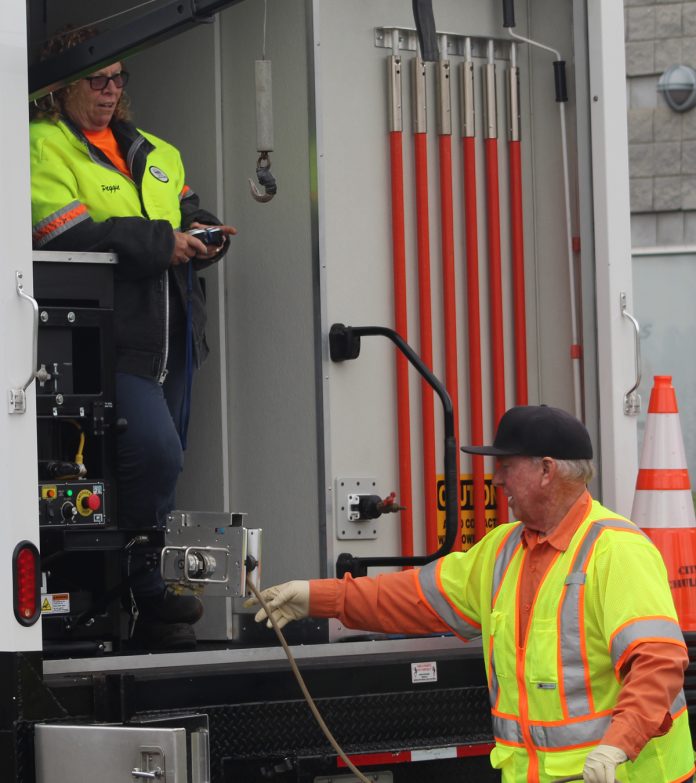
Peggie Mazzeppi spends around nine hours a day using an Xbox controller. The 30-year veteran employee of the city of Chula Vista is not battling dragons or fighting in imaginary battles, however, but rather making sure residents can properly flush their toilets.
Mazzeppi is part of a team of Public Works employees – the TV Van Crew — whose job entails driving a 75-pound camera through over 500 miles of city sewer line, looking for obstructions or damage to the line itself.
“If it wasn’t for us finding problems, you’re going to flush the toilet and it ain’t going to go down,” Mazzeppi said.
Mazzeppi has been on camera duty for around 10 years, and, with partner Sergei Senoff, works her way down city streets in a van equipped with monitors and other equipment, going manhole to manhole in order to find and send important data and imagery to city engineers.
“I just love my job,” Mazzeppi said. “Women are usually in offices, and I’m not in an office.
I don’t think I would be conducive to an office environment. I’m just passionate that I get to work and do something different every day.”
Senoff, who has worked with Mazzeppi on the TV van for two or three years, said being in Public Works has made him a “well-rounded individual.”
“You’re not doing the same thing day in, day out. There’s always something new to learn, something new that you’ve never seen before,” Senoff said.
The crew has filmed 93% of the lines in Chula Vista, running reports on two, three, four and five year timeframes in order to ensure no part of the sewer is being forgotten.
Iracsema Quilantan, Chula Vista’s director of public works, said the TV Van Crew does an important service to the city.
“The critical function to be able to go out and TV these lines is we’re being proactive,” Quilantan said. “We’re being proactive in managing that asset, which then says we’re able to plan capital improvements, but we’re also able to reduce our costs because if we can proactively identify what the issue might be then we can act upon it before it becomes an emergency.”
A notable incident of near catastrophe came around two or th qree years ago, when a forming sinkhole near Valle Lindo Elementary threatened the health and safety of students, staff and parents.
The team was able to find and address the problem – a disintegrated pipe – before any further damage was done.
“Because of our initial response when we were told there was this a sinkhole developing, we avoided, you know, a lot of, probably major issues and got it repaired,” said Mark Sanchez, the crew’s manager.
There are a variety of different reasons that a pipe may be in need of repair, such as obstructions from roots or grease, or cracks in the piping. Some areas of clay piping – mainly on the city’s west side — can be over 100 years old.
“There’s a good feeling when you come across a situation, heavy roots or a break in the line and you know you prevented something that could have been disastrous,” Sanchez said.
Untreated lines can lead to blockages, overflows and street failures, such as sinkholes. Root obstructions are fixed by calling in what is known as the rotting truck, while grease buildups are attended to by what is called the flushing truck.
“We’re making sure that, even though it kind of sounds like it’s not important, we’re making sure that… (residents) can flush a toilet, they don’t have to worry about a sewer overflowing and getting into the yard and getting into the environment. We’re there to protect them from that,” Sanchez said.
The camera itself is about 24 inches long and has six wheels – two rubber and four steel aggregate – which helps give it traction while driving along slippery surfaces.
